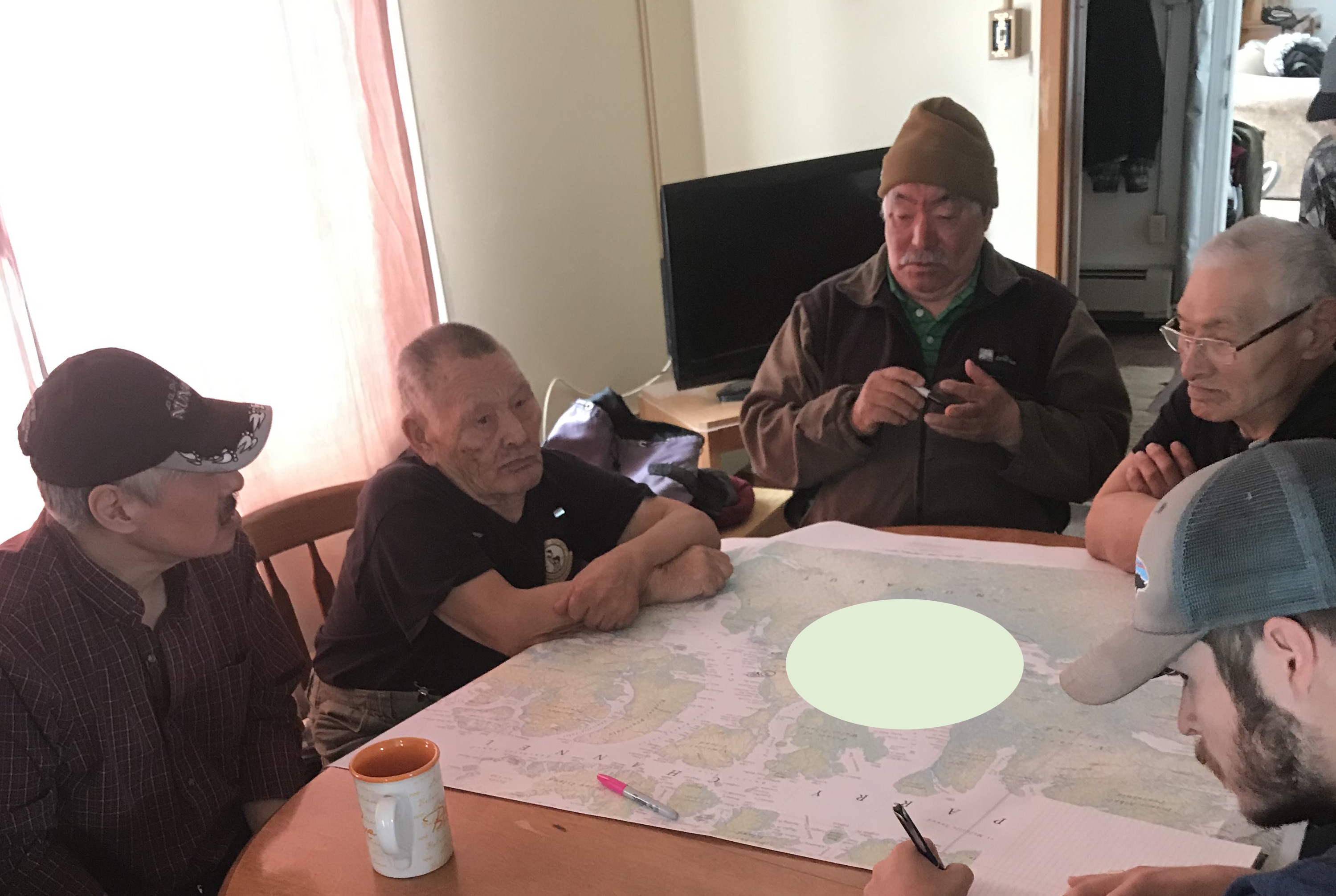TEK workshops: Difference between revisions
No edit summary |
No edit summary |
||
| Line 6: | Line 6: | ||
As part of this GE3Ls activity three TEK mapping workshops were co-designed with the HTA of Gjoa Haven to ‘identify TEK gaps’ and ‘fill them’. The temporal and spatial polar bear TEK that was collected, was processed and published in the MES thesis of Scott Arlidge, another student that participated in the project. It ‘provides a georeferenced knowledge base that displays information on polar bears including harvest sites, bear movement, denning sites, and hunter knowledge areas’ (Arlidge, 2022 p.13). The data as shared in this publication is presented in this thesis as i) ‘a historical record of polar bear knowledge for the community of Gjoa Haven’; and ii) ‘as a guide to areas of high polar bear activity for future targeted polar bear monitoring effort’s’ (Arlidge, 2022 p.ii). | As part of this GE3Ls activity three TEK mapping workshops were co-designed with the HTA of Gjoa Haven to ‘identify TEK gaps’ and ‘fill them’. The temporal and spatial polar bear TEK that was collected, was processed and published in the MES thesis of Scott Arlidge, another student that participated in the project. It ‘provides a georeferenced knowledge base that displays information on polar bears including harvest sites, bear movement, denning sites, and hunter knowledge areas’ (Arlidge, 2022 p.13). The data as shared in this publication is presented in this thesis as i) ‘a historical record of polar bear knowledge for the community of Gjoa Haven’; and ii) ‘as a guide to areas of high polar bear activity for future targeted polar bear monitoring effort’s’ (Arlidge, 2022 p.ii). | ||
'''[[Wayfaring the BW project Point of Beginning#Workshops Summer 2019|Click here]] to go (back) to Workshops Summer 2019''' | |||
Revision as of 14:15, 4 November 2024

The BearWatch project was designed to include a “Genomics and its Environmental, Economic, Ethical, Legal and Social aspects (GE3LS)” component. GE3LS is described on the Ontario Genomics website as investigating ‘questions at the intersection of genomics and society’, and as ‘providing stakeholders with the insights needed to anticipate the impacts of scientific advances in genomics, avoid pitfalls, cultivate success, and ultimately, contribute to Canada’s leadership in the 21st-century global bioeconomy’ (Ontario Genomics, accessed 04-11-2024). Within the BearWatch project proposal GE3LS was interpreted and included as the ‘Evaluation, Mapping and Integration of Polar Bear Inuit Qaujimajatuqangit/Traditional Ecological Knowledge (IQ/TEK), Historical Records and Science’, with the goal of guiding faecal sampling and to develop a long-term and viable monitoring program using community based field collection and leading-edge genomics science (BearWatch research proposal, 2016 p.30). The purpose of this was ‘to increase community ownership of polar bear monitoring through community-based collection and knowledge sharing’ and to respond to the ‘legal authority of land claim agreements, asking that IQ/TK be used to make management decisions’ (BearWatch research proposal, 2016 p.30-31). Along the way, the proposed activities under the GE3LS component were adjusted and in some cases downscales for feasibility purposes based on feedback from Research Committees and community feedback. Activities to ‘identify TEK gaps’ and ‘fill them’ (Schedule H report, March 2019) were narrowed to focus more on partner communities, through ‘case studies’ that would help inform broader suggestions on monitoring.
As part of this GE3Ls activity three TEK mapping workshops were co-designed with the HTA of Gjoa Haven to ‘identify TEK gaps’ and ‘fill them’. The temporal and spatial polar bear TEK that was collected, was processed and published in the MES thesis of Scott Arlidge, another student that participated in the project. It ‘provides a georeferenced knowledge base that displays information on polar bears including harvest sites, bear movement, denning sites, and hunter knowledge areas’ (Arlidge, 2022 p.13). The data as shared in this publication is presented in this thesis as i) ‘a historical record of polar bear knowledge for the community of Gjoa Haven’; and ii) ‘as a guide to areas of high polar bear activity for future targeted polar bear monitoring effort’s’ (Arlidge, 2022 p.ii).
Click here to go (back) to Workshops Summer 2019
